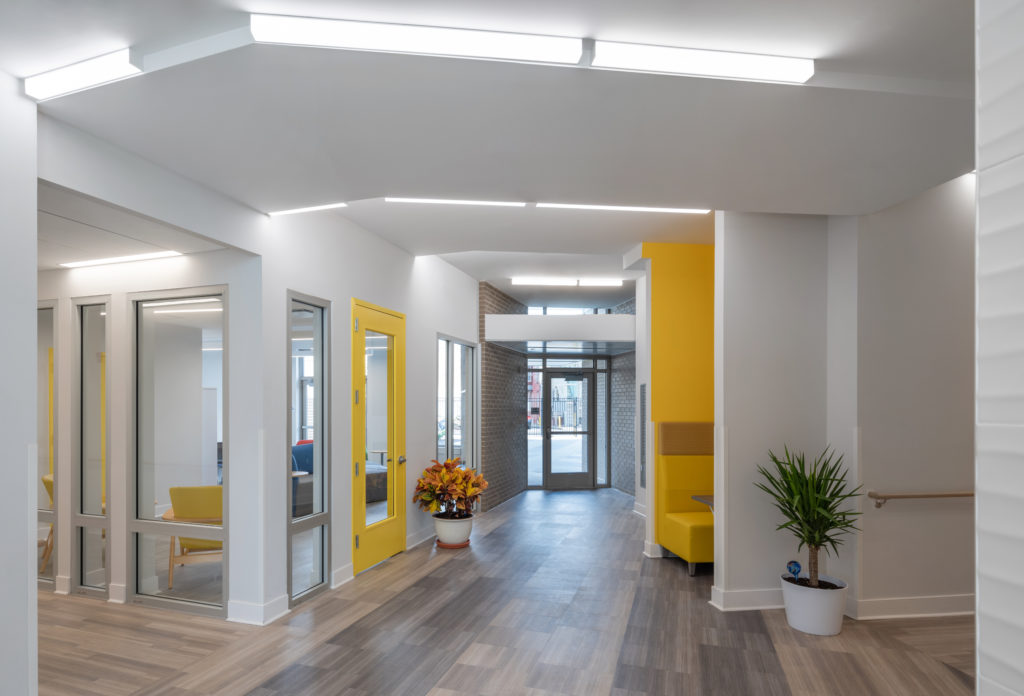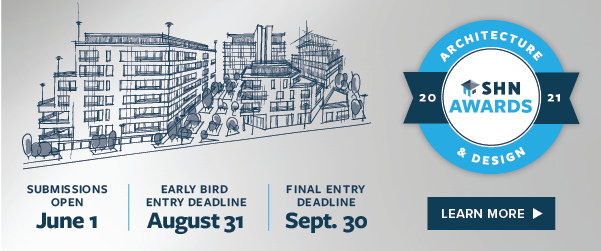Best Affordable Design of 2020: $16M Casa Indiana Brings Neighborhood Culture Into Eco-Friendly Building
The Fairhill neighborhood of Philadelphia dates back to the City of Brotherly Love’s founding, but it has changed a lot over the years — and a recently opened senior living community reflects the neighborhood’s culture while also meeting its current needs.
In the 1950s, Fairhill became home to African Americans and Hispanic Americans, mainly Puerto Ricans. Today, Fairhill is known for having one of the highest concentrations of Puerto Ricans in Philadelphia. The community is now served by Casa Indiana, a 50-unit, $16 million development from the Hispanic Association of Contractors and Enterprises (HACE), is a linchpin in that organization’s 29-year mission to bring equitable housing and services to Philadelphia’s Hispanic population, while calling back to the city’s history with an eye toward the future.
Building affordable housing is not an easy endeavor. In HACE’s case, it took several times to secure the necessary tax credits to make the project viable. And the arrival of Covid-19 in the U.S. delayed the project as it neared completion.
Ultimately, the building opened to wide acclaim from residents and architects, and its unique use of space and design earned Casa Indiana top honors in the 2020 Senior Housing New Architecture & Design Awards’ “Best Affordable” category.
The concept
HACE launched in 1982 with a mission to build affordable rental housing for families and senior citizens, affordable single family homes, and commercial spaces to provide equity mechanisms for Hispanic people in their neighborhood, President and CEO Maria Gonzalez told Senior Housing News.
HACE focuses its efforts on Fairhill and the adjacent neighborhood, St. Hugh, creating 10-year neighborhood plans with feedback from the community and stakeholders, identifying key locations for projects and activities in the neighborhoods, as well as necessary services.
 Kendon Photography
Kendon PhotographyFairhill is home to the highest concentration of Puerto Ricans in Philadelphia. According to 2010 Census Bureau data, 80.2% of the neighborhood’s population identifies as Hispanic.
Casa Indiana is located near a railroad gulch and across the street from what once was a notorious heroin and opioid market, Daryn Edwards, director of design for Philadelphia-based CICADA Architecture, told SHN.
“[The markets] had been there for over 30 years before [the opioid epidemic] exploded,” he said.
Popular Reports
Advertisement
HACE, with assistance from the city and Conrail, which owns the railroad, worked together to eradicate the market and move forward with the plan. The firm was already active in Fairhill, building a multipurpose trail along Gurney Street to provide connectivity between the neighborhood’s endpoints.
The need for affordable housing in Fairhill is significant. As of 2010, 46% of the senior population in HACE’s service area lived below the poverty line. Moreover, delivery of social services can be a maze for Spanish-speaking seniors — many of whom prefer to seek assistance from familiar organizations within their neighborhoods.
Casa Indiana was built for independent seniors, but can be adapted to provide supportive living services as they age. Elevator lobbies are wide for ease of movement. Each floor uses primary colors as a wayfinding device and in celebration of Fairhill’s Puerto Rican heritage. The building itself is situated on a north-south lot to provide ample daylight to enter apartments and common areas during the day.
That site layout allowed CICADA to design a “secret garden” in back that provides shade during peak afternoon hours, and reduces noise pollution emanating from a busy intersection near the front of the building.
 Kendon Photography
Kendon PhotographyOne of the most important tweaks of the project is a peel of one corner of the site for a pocket plaza, ringed with sculptures designed by Marta Sanchez, a local sculptor, which draws inspiration from Fairhill’s history of freight rail and commerce, and its deep Puerto Rican heritage. This plaza will connect directly to the Gurney Street trail and to Willow Park, a public park HACE is developing down the street.
The construction
One of the biggest hurdles to getting Casa Indiana off the ground was securing the financing for the project. Typically, building new affordable housing developments requires securing low-income housing tax credits.
HACE applied for 9% tax credits — a 70% subsidy for a new development’s cost — four times before finally receiving approval. This process required the firm to submit updated paperwork every time, including environmental surveys, appraisals, and market studies compiled by a housing consultant. This did not come cheap, but tax credits are the only way to make affordable developments pencil out, Gonzalez told SHN.
“Every application costs between $75,000 and $100,000,” she said. “It’s the only game in town.”
Along with the tax credits, HACE received $2 million from the city of Philadelphia, $1.8 million in funding from the state of Pennsylvania, and a $406,000 grant from Federal Home Loan Bank of Pittsburgh.
Once Casa Indiana’s capital stack was in place, HACE broke ground on the development in May 2019 and construction moved along at a brisk pace.
 Kendon Photography
Kendon PhotographyOne issue the development team addressed in the early weeks was site remediation, to remove contaminated soil when construction crews laid the building’s footings and foundation. This effort could have added expenses to the budget and extended the construction timetable if not managed properly. During the remediation process, crews discovered an oil tank that led to a delay, Edwards said.
Construction continued apace in the proceeding months and Casa Indiana neared completion as the first wave of positive coronavirus cases swept the country last spring. Suddenly, work on the development was temporarily halted as the state and city mandated moratoriums on non-essential construction.
Two weeks later, the project’s general contractor was able to receive a waiver to restart work, but work was further delayed as safety protocols were put in place on site to reduce the risk of an outbreak, and liability insurance was reviewed to ensure compliance with the waiver.
In total, construction was halted for 45 days, and Gonzalez noted that HACE was fortunate the project was near completion and the delay did not adversely affect the budget from a materials standpoint.
“We didn’t have a lot of time to make up,” she said.
The legwork done by HACE to get the development underway freed CICADA to focus on designing the best building possible. Edwards and his team took Gonzalez’s challenge to design a building that they would feel comfortable living in to heart. And the design process started with balancing bringing in daylight to the residences with maintaining the building’s energy efficiency and sustainable components.
 Kendon Photography
Kendon PhotographyAll of Casa Indiana’s apartments are hitting 50 or lower on the HERS [Home Energy Rating System] scale, which dictated the size of the windows and their placements.
“We wanted [apartments] to be light-filled,” he said. “It was a balancing act between how large we could make the windows and still meet very aggressive energy performance as part of the HERS index.”
As a developer and property manager, HACE champions sustainability in its buildings because it leads to long-term savings on expenses. It is willing to invest in durable building materials, such as large ceramic tiles in its elevator lobbies that resemble waves, which require less maintenance and extend the lifespans of its properties.
“If we’re able to maintain operating costs, that means that we are not going to pass those expenses on to our residents,” Gonzalez said. “We know that the population that we are marketing to can’t afford standard [annual] market increases for rent.”
The completion
Casa Indiana opened last June, one month later than expected and as the first wave of Covid-19 cases receded and senior housing providers shifted to a management phase of the pandemic.
The pandemic forced HACE to reconsider its aggressive, pre-outbreak lease-up pro-forma, initially 10 per month. Instead, leasing and move-ins started in late June and ran through the end of July, to ensure the safety of new residents and fill the building’s 50 units.
 Kendon Photography
Kendon PhotographyThis required much effort on the part of the group’s property management team, working in a remote environment. This team was fortunate to have a waiting list of over 200 prospective residents from which to identify and approve the new move-ins, and get them situated in a safe manner through staggered move-ins.
“It was this well coordinated dance to make sure that people were not on top of each other,” Gonzalez said.
Casa Indiana’s residents are ecstatic to live in the building, in spite of the challenges endured to move in.
As with seniors in communities across the country, however, they are feeling the effects of isolation. While the building’s resident services director has created virtual programming, residents cannot wait to return to an environment where they can participate in large scale activities and enjoy the building’s outside amenities.
The planning with which HACE and CICADA approached building near a busy intersection was not lost on Eric Krull, executive vice president at THW Design and one of this year’s judges. He was impressed by the way the development team peeled back the corner of the site to create the public plaza, which curates a memorable sense of personality in a meaningful way.
“You may not even live there. You may be out there with your child in a stroller in the neighborhood, but you’re reminded of a very important community service,” he said.
Peeling back the corner for the plaza allowed the architects to play with what would have otherwise been a basic rectangular building, giving the team options to place kinks in the building’s design, improve wayfinding with shortened corridors and bring in more daylight.
“If I lived at one end of the building, I know my journey is only halfway down and I get to see what is going on outside,” he said. “It’s the synergy that little kink created in the building.”
Casa Indiana’s design stood out for Thoma-Holec Design Principal LuAnn Thoma-Holec, another of this year’s judges. She highlighted the bold use of color in passageways as a wayfinding device while also harking back to the neighborhood’s Puerto Rican heritage.
“Sometimes we shy away from the use of bold colors for seniors,” she said. “In this particular case, it was just very effective. I think it was appropriate for the demographic of the area.”
Thoma-Holec had high praise for Sanchez’s sculptures and the apartment appointments, specifically identifying good use of space throughout, while the large glazed windows allow ample light to enter the units. But she saved her highest praise for the level of research HACE did in putting the development together, and delivering a product that can serve as the catalyst for future projects, as well as an economic driver for the neighborhood.
“They really did their research in terms of the site and the socioeconomic conditions of the senior population there,” she said.


